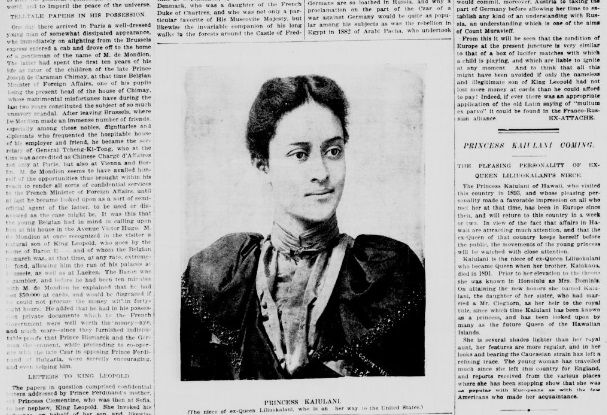In honor of National Women’s History Month, our Kūkahekahe cultural conversations column shares the mo‘olelo of me‘e wāhine – women heroes – who have helped to shape Hawaiʻi. Here is the story of our beloved Princess Kaʻiulani who fought with strength and compassion for her nation, as a young woman of distinction. To learn more about these meʻe wāhine, follow Kaʻiwakīloumoku on Instagram and Facebook!
Born on October 16, 1875, Victoria Kaʻiulani Kawēkiu i Lunalilo Kalaninuiahilapalapa Cleghorn was the only child of Princess Miriam Likelike, who was sister to both King Kalākaua and Queen Liliʻuokalani. Kaʻiulani’s father was the prominent Scottish businessman Archibald Cleghorn.
Kaʻiulani was instantly beloved by her family. At her birth, Princess Keʻelikōlani gifted Kaʻiulani with an estate in Waikīkī which Likelike would name ʻĀinahau. As she grew, she remained close to her aunt, Liliʻuokalani. Kaʻiulani was raised to be a leader for her people with the expectation that she might one day rule.
She attended school in England at the age of 13, after the passing of her mother, with the understanding that it would provide a foundation for her as a future ruler. She was fluent in Hawaiian, English, French and German. At the age of 15, Kaʻiulani was proclaimed Crown Princess of Hawaiʻi by Liliʻuokalani, who had ascended the throne after the death of Kalākaua in 1891.
On January 17, 1893, the monarchy was overthrown and Queen Liliʻuokalani was deposed. It was just two years later that Kaʻiulani was proclaimed heir apparent, but she was still away from the islands at the time. Heartsick, Kaʻiulani composed a statement to the press in England, which was eventually reprinted in “The Daily Bulletin” on March 2, 1893, in Honolulu.
The Princess’ letter read:
“Four years ago, at the request of Mr. [Lorrin A.] Thurston, then a Hawaiian Cabinet Minister, I was sent away to England to be educated privately and fitted to the position which by the constitution of Hawaii I was to inherit. For all these years, I have patiently and in exile striven to fit myself for my return this year to my native country.
I am now told that Mr. Thurston will be in Washington asking you to take away my flag and my throne. No one tells me even this officially. Have I done anything wrong that this wrong should be done to me and my people? I am coming to Washington to plead for my throne, my nation, and my flag. Will not the great American people hear me?”
Kaʻiulani traveled to the U.S. in hopes of appealing to the hearts of the American people. The press, whose initial inclinations were racist, noted her arrival and were won over by the princess’ poise, eloquence, and intelligence. Kaʻiulani spoke to audiences, hoping to inspire support for the restoration of the kingdom. Kaʻiulani provided another statement, which was published in newspapers across the nation:
“Unbidden, I stand upon your shores today where I thought so soon to receive a royal welcome on my way to my own kingdom. I come unattended, except by the loving hearts that have come with me over the wintry seas. I hear that commissioners from my land have been for many days asking this great nation to take away my little vineyard. They speak no word to me, and leave me to find out as I can from the rumors of the air that they would leave me without a home, or a name, or a nation…
“Today, I, a poor, weak girl, with not one of my people near me, and all these Hawaiian statesmen against me, have strength to stand up for the rights of my people. Even now I can hear their wail in my heart and it gives me strength and courage and I am strong, strong in the faith of God, strong in the knowledge that I am right, strong in the strength of 70,000,000 people who in this free land will hear my cry, and will refuse to let their flag cause dishonor to mine.”
Although Kaʻiulani was admired and respected by many of the American audience, her pleas could not right the injustices that had occurred. She remained in Europe for the next few years, returning to Hawaiʻi in 1897 after nearly nine years abroad. Kaʻiulani and Liliʻuokalani boycotted the 1898 ceremony for the annexation of Hawaiʻi, and they continued to work to ensure the rights of the Hawaiian people under the U.S. government.
While on a horse ride on Hawaiʻi Island just one year later, she got caught in a storm and developed a fever. Kaʻiulani was brought back to Oʻahu where her health continued to decline. She died on March 6, 1899, at the age of 23.
Princess Kaʻiulani demonstrated throughout her life the strength and compassion of aloha that her family and the Hawaiian people instilled in her. She embodied the qualities of a true aliʻi Hawaiʻi, and she fought for her nation as a young woman of distinction.

The “New-York Tribune published a story, “Princess Kaiulani Coming: The Pleasing Personality of Ex-Queen Queen Liliuokalani's Niece” on Sept. 12, 1897 in a special illustrated supplement.
Related stories
TAGS
women's history month,
me'e wahin,
princess ka'iulani,
hookahua,
'ōiwi leader
CATEGORIES
Kaipuolono Article, Regions, Themes, Culture, Community, Hawaii Newsroom, KS Hawaii Home, Kapalama Newsroom, Kapalama Home, Maui Newsroom, KS Maui Home, Newsroom, Campus Programs, Hawaii, Kapalama, Maui, Department News
Print with photos
Print text only










